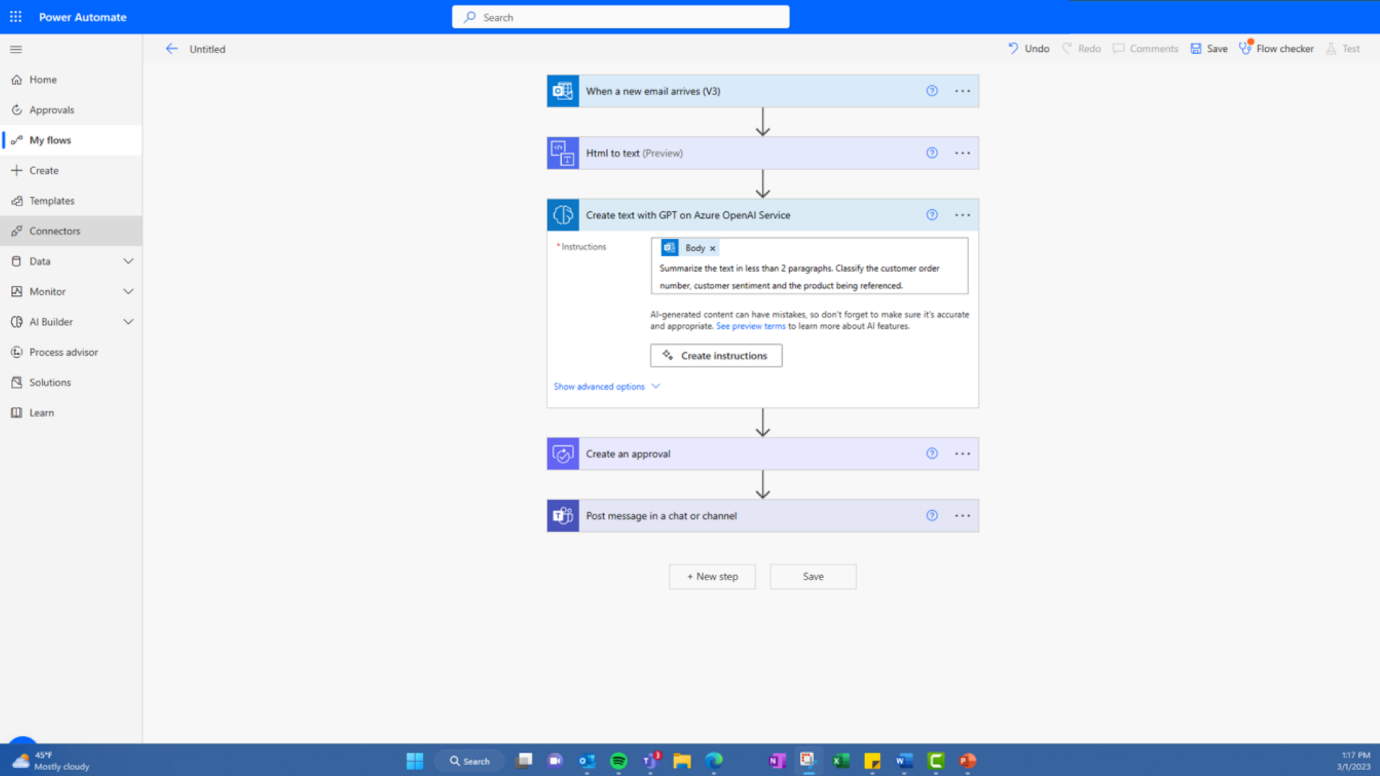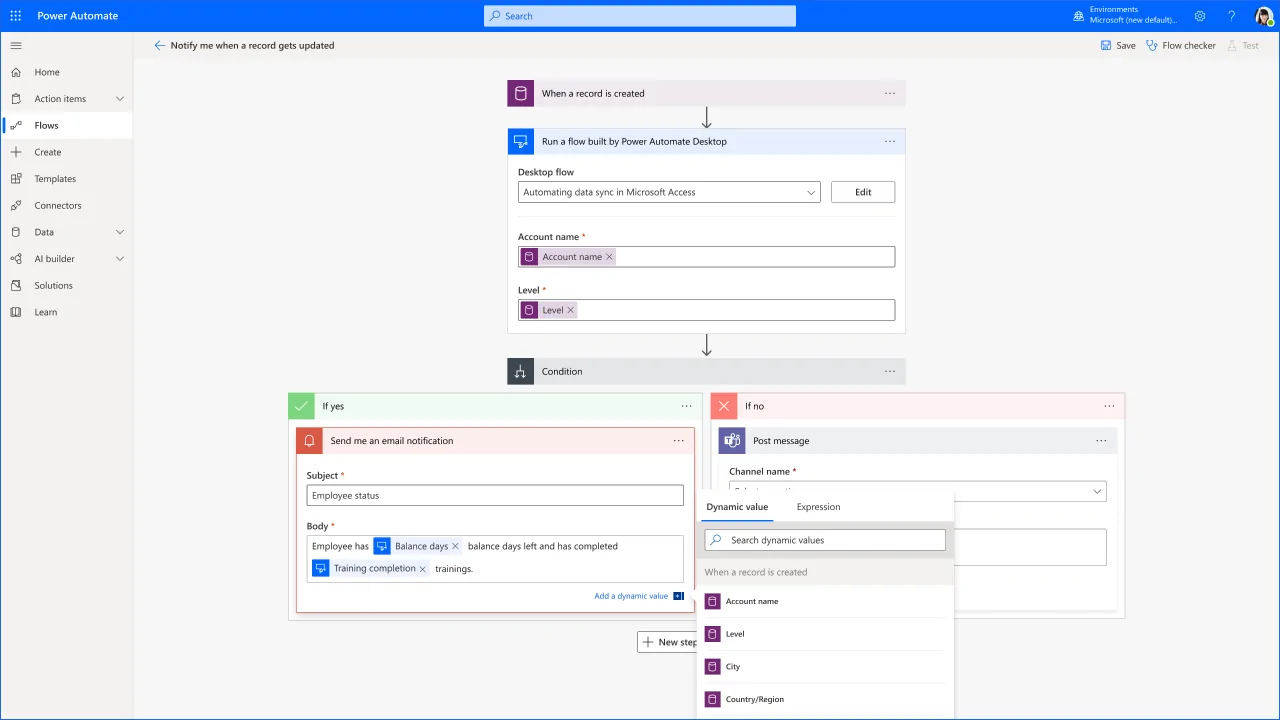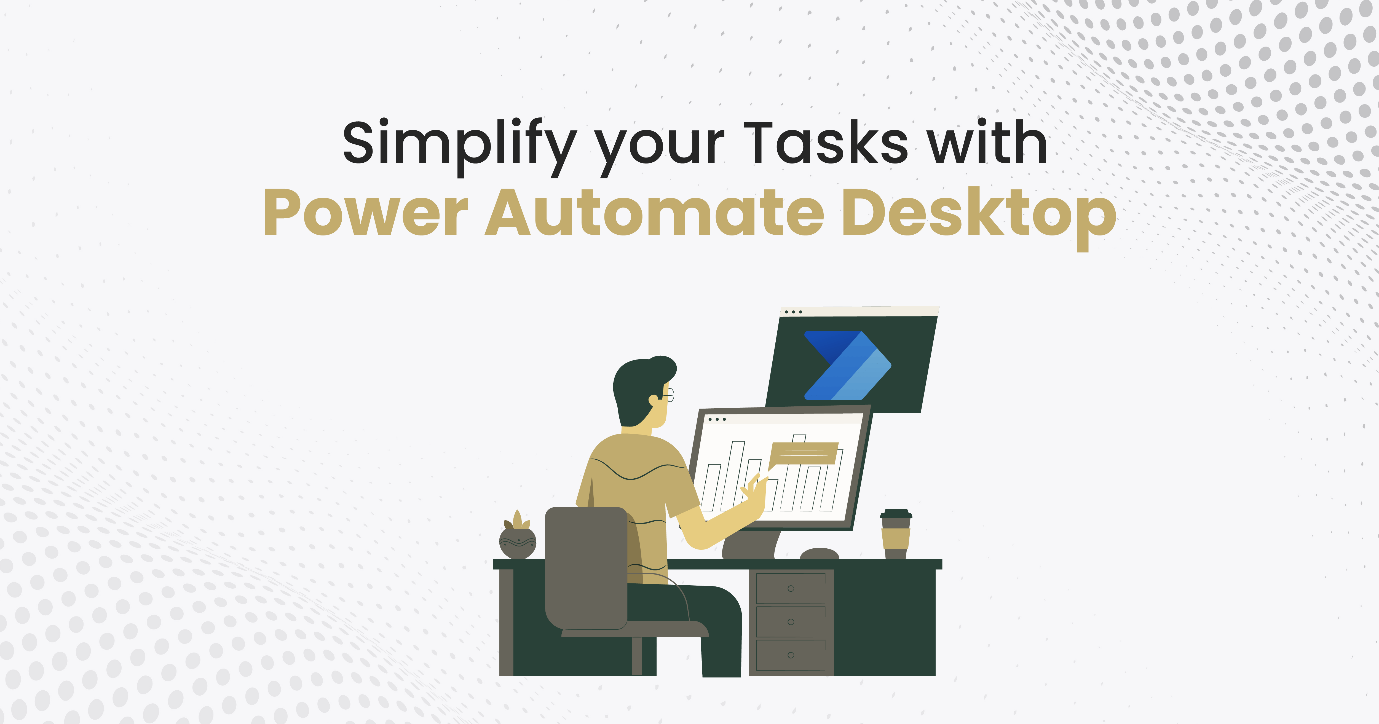In today’s digital age, top managers find amazing value in products such as Microsoft’s Power Automate Desktop (PAD). Power Automate Desktop is your computer’s version of a superhero. It makes tasks more automated, so you don’t need to be a computer expert. How can it occasionally be necessary to repeatedly perform the same boring computer activities? Fortunately, Power Automate Desktop handles those for you, which speeds up and simplifies your work.
The great thing about Power Automate Desktop is that it offers more benefits than improved efficiency. It facilitates improved collaboration and significant cost savings for companies. Since PAD is part of the large Microsoft tool family, it integrates perfectly with other products you may already use. Your work becomes even more integrated and productive as a result. In today’s fast-paced corporate world, where things are constantly changing, PAD is like a secret weapon. It helps businesses to survive, expand, and overcome their competitors. To learn more about how Power Automate Desktop may help managers become leaders in the age of technology, read this article.
What is Power Automate Desktop?
Power Automate Desktop is a robust tool for automating computer processes. It makes it possible to design processes that can manage files, do data extraction, and enter and process repeated data. Power Automate Desktop allows users to increase productivity and save time. Because of its simple interface, people with and without technical expertise may quickly develop and maintain automation workflows. Both people and organizations can prioritize more meaningful work and improve their procedures by implementing Power Automate Desktop.
Why Power Automate Desktop?
Power Automate Desktop (previously Microsoft Flow) automates repetitive actions like mouse clicks and keyboard taps in the same way that functions do in the Microsoft Office product suite. Repetitive processes can be reduced and streamlined by creating operational flows on your desktop by recording and replaying the actions to automate the recorded functionality.

In contrast to Office macros, Power Automate Desktop flows let you combine clicks, taps, and actions from several websites and programs. Then, using a powerful content creation experience, you may further edit your recordings using a drag-and-drop visual interface to expand and customize the data flow with over 400 specified activities.
Furthermore, Microsoft launched their enterprise Power Automate data workflow tool within Power Platform on April 1st, and your company can use it to deploy low-code, rich data workflow, and integration solutions across various on-premises and cloud-based applications for $15 per user per month. The Power Automate platform offers more than 400 prebuilt system connectors, and new ones are added every month.

It is part of Microsoft’s Robotic Process Automation (“RPA”) program, which aims to boost productivity by significantly reducing manual and repetitive daily data activities.
Benefits Of Using Power Automate Desktop
In today’s fast-paced world, time is a vital resource, and any chance to streamline operations and save time is highly valued. Power Automate Desktop can help with this. The advantages of using Power Automate Desktop will be discussed in this part, along with how it may reduce human error, increase productivity, and automate repetitive operations. You’ll see why this technology is revolutionary for individuals and businesses by the end.
Automate Repetitive Tasks
Using Power Automate Desktop to automate repetitive processes might help you save time and effort. The steps to automate tasks are as follows:
Identify the Tasks: Choose the task that you want to automate.
Record the Steps: Use the recorder tool to record the task’s steps.
Edit and Refine: Edit the recorded steps as appropriate, adding loops or conditions as required.
Observe the Flow: Check the flow and make sure the task is completed successfully.
Save and Schedule: Save the flow and schedule it to run automatically at specific times.
Consider the following tips for a successful use of Power Automate Desktop:
Start with simple tasks: Begin with small tasks by automating to become skilled with the program.
Use variables & loops: Loops are used to repeat activities, while variables store and modify data.
Test and debug frequently: To make sure your flows are operating smoothly, test and debug your flows frequently.
Increase Efficiency and Productivity
You can work much more effectively and productively if you use Power Automate Desktop. Use Power Automate Desktop to boost efficiency and productivity by following these steps:
- Identify time-consuming manual procedures that are repetitive.
- In Power Automate Desktop, create a flow to automate certain tasks.
- Add actions that repeat your manual steps to improve the flow.
- Run the flow to confirm that it works as planned.
- Monitor the flow to discover any potential problems and improvements.
You can save time and concentrate on more important areas of your career by automating repetitive tasks. Your workflow is streamlined by Power Automate Desktop, which reduces errors and increases output.
Manufacturing techniques changed by the Industrial Revolution in the late 18th and early 19th centuries, which increased production and efficiency. Mechanized textile production, the assembly line, and the steam engine were among the innovations that transformed industries and raised living standards while also boosting economic growth. This historical example emphasizes the importance of efficiency and production in promoting progress and development.
Reduce Human Error
One of the main advantages of using Power Automate Desktop is a reduction in human error. Task automation helps increase accuracy and reduce errors. Here are the actions to take to reduce human error when using Power Automate Desktop:
- Determine which tasks are error-prone and repetitive.
- To automate these tasks, create a flow in Power Automate Desktop.
- Integrate safety measures like validations and error management.
- Test and debug the flow frequently to make sure there are no mistakes.
- Keep an eye on the flow’s performance and make any necessary changes.
How To Get Started With Power Automate Desktop?
Are you ready to use Power Automate Desktop to simplify your work and increase your output? Now let’s explore how to use this effective automation tool. At first, we will help you with downloading and setting up Power Automate Desktop on your system. After that, we’ll guide you through using the user-friendly interface and becoming aware of its capabilities. Prepare to transform your work process with Power Automate Desktop!
Download and Install Power Automate Desktop
Following are the steps to install and download Power Automate Desktop:
- Check out the Microsoft Power Automate website officially.
- Select the “Pricing” tab.
- After scrolling down, choose “Power Automate Desktop.”
- Select the “Free Download” option.
- Download the installation file by following the directions on the screen.
- Double-clicking the file will start the installation procedure after it has finished downloading.
- Agree the terms and conditions by following the instructions.
- After selecting the installation location, click “Install.”
- Wait for the installation to complete.
- After Power Automate Desktop has been properly installed, run it to begin automating your tasks.
Familiarize Yourself with the Interface
To use Power Automate Desktop properly, you must become familiar with its UI. To get started, follow these steps:
- Install Power Automate Desktop, then log in with your credentials.
- Examine the toolbar, flow canvas, and activity panel on the main screen.
- Make note of the different options available in the toolbar, including executing, saving, and creating new flows.
- Learn the available activities by dragging and dropping the activity panel into the flow canvas.
- Consider including tasks and connecting them to create a basic flow.
- Press the “Play” button to preview your flow while you see the activities being carried out.
To get the most out of Power Automate Desktop, follow these steps:
- Use the wide variety of pre-built activities to automate repetitive chores.
- To find out more about best practices and advanced features, go through the documentation and online resources.
- To increase your skill, create and test flows regularly.
How To Create a Flow in Power Automate Desktop?
If you’re new to Power Automate Desktop, the process of establishing a flow can seem complex. But worry not—we’ll guide you through the process of setting up a flow in Power Automate Desktop. You will be guided through the three main phases in this section: selecting a trigger, adding actions, and testing and executing the flow. You’ll know more about how to use this effective tool for job automation by the end. Now let’s get started and create our first Power Automate Desktop flow.
1. Choose a Trigger
The first step in building a flow in Power Automate Desktop is to choose a trigger. The trigger defines when your flow starts. The steps of choosing a trigger are as follows:
- After launching Power Automate Desktop, choose “Create a new flow.”
- Go to the “Start” section and select “Choose a trigger.”
- Choose the trigger that best meets your automation requirements by looking through the various options.
- If necessary, adjust the trigger’s settings by defining its frequency or criteria.
- To move on to the next stage of developing your flow, click “Next.”
There are many different types of triggers available in Power Automate Desktop, such as application events, time-based triggers, and triggers based on external systems or devices.
2. Add Actions
To add activities to Power Automate Desktop, take the following actions:
- In the Flow Designer, click the “Add” button.
- From the list of options, choose the required action.
- Give the action the required inputs and settings to configure it.
- To add more actions to your flow, repeat steps 2 and 3.
- Drag and drop the actions to put them in the appropriate sequence.
- If required, set up any loops or conditions.
- To make sure your flow is working properly, save it and give it a test.
Consider the following tips for using Power Automate Desktop effectively:
- Use subfolders and folders to properly organize your actions.
- Note the objective of each activity in the comments section.
- To store and manage data, use variables.
- Use loops to repeat actions.
- Test and debug your flows frequently to find and fix any problems.
3. Test and Run the Flow
To make sure the flow in Power Automate Desktop is accurate and efficient, testing and running it is an essential step. The steps to run and test a flow are as follows:
Examine the flow: Make sure everything is configured properly by reviewing the actions and variables used in the flow again.
Simulate the flow: To execute the flow without really doing anything, use the “Simulate” option. It allows you to confirm whether the flow is operating as planned.
Debugging the flow: If there are any problems throughout the simulation, make use of the “Debug” option to locate and fix the problematic sections.
Run the flow: Select the “Run” option to start the flow and automate the appropriate job or procedure after you are comfortable with its operation.
One user designed a flow in Power Automate Desktop to automatically organize and rename downloaded files. They executed the flow after carefully checking its accuracy and saving a significant amount of time by minimizing the need for manual file maintenance.
What Kind of Flows Can You Make Using Power Automate Desktop?
With the help of Power Automate Desktop, you may save time and effort by streamlining repetitive activities. However, what specific uses are this automation software capable of? Here, we’ll look at some real-world examples of flows that Power Automate Desktop can help you develop. The possibilities are numerous, ranging from scheduling social media postings to automatically preserving email attachments to automating data entry tasks. Let’s get started and discover how this tool can improve the productivity and efficiency of your work.
Automatically Save Email Attachments to OneDrive
Use Power Automate Desktop to save email attachments to OneDrive automatically by following these steps:
- Open Power Automate Desktop, and begin a new flow.
- After selecting the “Email” trigger, link it to your email address.
- Configure the trigger to alert you when new emails with attachments arrive.
- To save the email attachment to a particular OneDrive folder, add an action.
- Configure the action to give the folder location and file name.
- To begin automatically storing email attachments to OneDrive, save and execute the workflow.
Schedule Social Media Posts
Use Power Automate Desktop to schedule social media posts by doing the following steps:
- Open Power Automate Desktop and create a new process.
- Add a trigger, like “When a new tweet is posted,” for the social media network of your choice.
- Include actions such as “Compose tweet” and “Schedule tweet” to help with post composition and scheduling.
- Set the desired publish date and time and enter the content.
- To make sure the flow is operating properly, test and execute it.
In the past, manually scheduling social media posts was error-prone and time-consuming. However, with the advancement of technology in social media management, organizations can now streamline their strategies and save significant time and effort. Power Automate Desktop and other automation technologies have made the procedure considerably more productive and efficient.
Automate Data Entry Tasks
Accuracy and efficiency can be significantly increased by automating data entering processes. The steps to use Power Automate Desktop to automate data-entering operations are as follows:
- Decide whatever particular data-entering task you want to automate.
- Open Power Automate Desktop, and begin a new flow.
- Decide the trigger to use, such as launching a particular program or opening a specific file.
- Include activities in the flow, including copying and pasting information or putting data into specified fields.
- For activities involving dynamic or repetitive data entry, use loops and variables.
- Test the flow to ensure it accurately performs the required data entering steps.
- To automate the Automate Data Entry Tasks, run the flow.
Data entry operations were time-consuming and prone to errors before the introduction of automation solutions such as Power Automate Desktop. Manual entry of data typically leads to inefficiencies and errors. Businesses have seen significant time savings and increased accuracy from automating data entry operations, freeing up staff members to concentrate on more important work.
Conclusion
To put it briefly, Power Automate Desktop works as a helpful desktop assistant by performing repetitive tasks for you, thereby saving time and minimizing mistakes. Efficiency isn’t the only benefit; it also strengthens bonds between teams and saves money for companies. It’s not necessary to be an expert user of computers to use it. Consider it an advantage for streamlining work in our rapidly evolving digital environment. With examples such as scheduling social media posts or automatically saving email attachments, the blog shows how to get started with it. All things considered, it’s an important tool for increasing productivity and ease of work.



